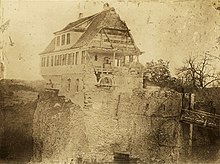Friedrich von Mandelsloh
Friedrich Graf von Mandelsloh (born December 29, 1795 in Stuttgart ; † February 15, 1870 Mergentheim ) was head forester in Urach and later district forestry officer in Ulm, as well as amateur geologist and amateur paleontologist .
Live and act
Friedrich Graf von Mandelsloh came from the noble Mecklenburg family of the Counts of Mandelsloh and was the second son of the Württemberg State Minister Ulrich Lebrecht von Mandelsloh (born February 16, 1760) and his wife Philippine, née. von Cramm (born November 25, 1752). He was the uncle of Kurt von Degenfeld-Schonburg . After going to school in Stuttgart, he joined the Guard as a lieutenant in 1812, but ended his military career, unsatisfied with his position, after three years to devote himself to forestry. To this end, he attended the Royal Saxon Forest Academy in Tharandt , where he studied forestry and general natural sciences under Heinrich Cotta's direction.


Returning to Württemberg, von Mandelsloh passed through all stages of the state forest administration in quick succession as a forest assistant, district office candidate, district forester and chief forester . As a chief forester in Urach , he negotiated with Wilhelm Graf von Württemberg about the purchase of the forester's house on the Lichtenstein with the associated land because of his first plans to build a castle on the Lichtenstein .
As a forester in Urach, he also carried out the first excavations in the Schiller Cave or the Schillingsloch near Bad Urach - Wittlingen on the Swabian Alb and found the bones of brown bears and lynxes as well as a well-preserved human skull. Unfortunately, he did not look for traces of settlement and simply dumped the excavation down the mountain in front of the cave. He put together a collection of his finds and bought additional finds, such as the bear bones that the potter Rixinger found while digging for clay and clay in 1830 in the hollow rock of Schelklingen .
Shortly afterwards he was appointed to Ulm as a district forestry officer. In his previous positions he had already dealt with the collection and determination of rocks and fossils and found in Ulm rich soil for geological studies. As a fruit of this, he presented the meeting of natural scientists and doctors in 1834 with a geognostic profile of the Swabian Alb, which he explained in detail in a publication "Mémoire sur la constitution géologique de l'Alb" (1834) published in Strasbourg . Through this work, von Mandelsloh acquired the reputation of being the first to know the geological conditions of Swabia. In particular, he deserves the credit of being the first to clearly recognize the significance of the stratification disturbances in the mountain structure of the Alb and to have determined that the current strata can often be proven as a result of the faults suffered. A borehole sunk at his suggestion to search for hard coal near Neuffen was unsuccessful, however, because von Mandelsloh had imagined the Swabian geological conditions too closely following the example of England, which he had got to know better in 1829.
Mandelsloh's diligence and diligence were praised as being particularly meritorious of having prepared a precise insight into the structure of the mountains of his homeland by carefully collecting rocks and fossils. His very substantial collection, which later went to the museum in Stuttgart and became a highlight of the exhibition there, retained scientific value despite the changes in the way in which the Jura layers were structured by Friedrich August von Quenstedt's work in the meantime .
His poor health compelled the hard-working researcher to resign from his position as early as 1854 and only later to move to Mergentheim in Stuttgart. Almost completely blind, he died there on February 15, 1870 at the age of 74.
family
On April 1, 1823, he married Countess Josephine von Degenfeld-Schonburg (* August 19, 1800 - January 14, 1877) in Altenstadt and had several children with her:
- Ulrich Ferdinand (February 10, 1824 - January 12, 1842)
- Gustav August (* January 18, 1825; † January 13, 1872) ∞ Louise Charlotte Elisabeth von Sayn-Wittgenstein-Berleburg (* March 7, 1833)
- Annetta Friederike (born August 2, 1826 - † September 8, 1829)
- Albrecht Friedrich (born August 30, 1830; † 1874), Lieutenant Colonel ret. D., owner of Bruchhof near Göttingen ∞ Henriette NN (born November 18, 1838)
- Bertha (* July 12, 1832; † April 12, 1833)
- Marie Anna (April 17, 1834 - June 7, 1834)
- Katharina Adele Henriette Ernestine (born January 7, 1837) ∞ NN
Works
- "Mémoire sur la constitution géologique de l'Alb" (1834)
literature
- Wilhelm von Gümbel: Mandelsloh, Friedrich Graf von . In: Allgemeine Deutsche Biographie (ADB). Volume 20, Duncker & Humblot, Leipzig 1884, p. 171 f.
- Oscar Fraas : Nekrolog des Count v. Mandelsloh , in: Annuals of the Association for Patriotic Natural History in Württemberg , 27th year, E. Schweizerbart, Stuttgart 1871, p. 28f.
- Carmen Rausche: Hohen Wittlingen and Schiller Cave
- Negotiations on the purchase of the forester's house on the Lichtenstein with the associated land, initial planning for the construction of a castle on the Lichtenstein , Baden-Württemberg State Archives, inventory GU 20: Lichtenstein Castle: construction, use and administration, 1st history of the castle construction: purchase negotiations.
- Gothaisches genealogical pocket book of the count's houses, 1870, p.645f
- Friedrich von Mandelsloh . In: Marcelli Janecki , Deutsche Adelsgenossenschaft (Hrsg.): Yearbook of the German nobility . Second volume. WT Bruer's Verlag, Berlin 1898, p. 525 ( dlib.rsl.ru ).
| personal data | |
|---|---|
| SURNAME | Mandelsloh, Friedrich von |
| BRIEF DESCRIPTION | German forester and geologist |
| DATE OF BIRTH | December 29, 1795 |
| PLACE OF BIRTH | Stuttgart |
| DATE OF DEATH | February 15, 1870 |
| Place of death | Bad Mergentheim |